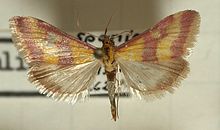Pyrausta sanguinalis, the scarce crimson and gold, is a moth of the family Crambidae. The species was first described by Carl Linnaeus in his 1767 12th edition of Systema Naturae.
| Pyrausta sanguinalis | |
|---|---|

| |

| |
| Scientific classification | |
| Domain: | Eukaryota |
| Kingdom: | Animalia |
| Phylum: | Arthropoda |
| Class: | Insecta |
| Order: | Lepidoptera |
| Family: | Crambidae |
| Genus: | Pyrausta |
| Species: | P. sanguinalis
|
| Binomial name | |
| Pyrausta sanguinalis | |
| Synonyms | |
| |
The wingspan is 14–18 mm. The forewings are brownish ochreous, basal and dorsal areas deep yellow, disc yellow mixed; markings purple-crimson; a streak along costa to 3/4; a fascia before middle; an oblong discal spot, connected above with costal streak, and sometimes beneath with preceding fascia; a subterminal fascia. Hindwings in male light grey, darker terminally, in female grey; termen crimson in middle. The larva is greenish-grey, reddish tinged; subdorsal and spiracular lines whitish; head brown.[1]
The moth flies from June to August depending on the location.
The larvae feed on common sage, rosemary and thyme.
References edit
- ^ Meyrick, E., 1895 A Handbook of British Lepidoptera MacMillan, London pdf This article incorporates text from this source, which is in the public domain. Keys and description
External links edit
- "Pyrausta sanguinalis (Linnaeus, 1767)". Catalogue of the Lepidoptera of Belgium. Archived from the original on 1 April 2012.
- Kimber, Ian. "63.004 BF1364 Pyrausta sanguinalis (Linnaeus, 1767)". UKMoths. Retrieved 10 December 2020.
- https://maps.biodiversityireland.ie/Species/79259, accessed 15 June 2021